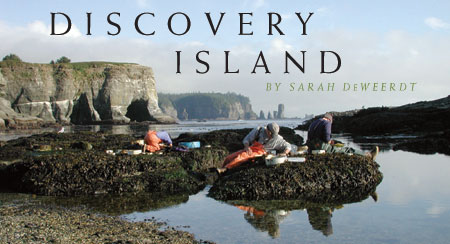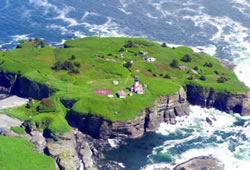

Since the lighthouse was automated in 1977, government agencies have largely abandoned the island. Paine and his crew have scavenged several of the ramshackle buildings left behind to create a makeshift field station. The researchers cook, eat, warm up, dry off, and analyze their data in a former Weather Bureau generator shed that they dubbed the Winter Palace. The 10-by-14-foot shack is stuffed to the gills with camping gear, ancient bottles of spices, old bolts and washers in plastic tubs, boxes of firewood, and other supplies and equipment. Over the years it has also acquired a collection of odd stuff: plastic toys and knick-knacks found washed up on the shore: a 10-year-old wall calendar, a yard flamingo dangling from the ceiling.
Paine is unmistakably king of the Winter Palace. He is a tall, broad-shouldered man, although his intellectual presence is so commanding that his physical presence hardly registers. He has an outer gruffness that cannot quite mask his enthusiasm for all things biological, but that enthusiasm cannot quite banish the gruffness, either.
He is given to 10-second pauses before answering a question, and, if the question is about ecology, you can feel the weight of an encyclopedic knowledge of scientific and natural history gathering behind his response.

On the island, Paine prefers to sleep in the Paint and Plumbing Shed, a rustic dormitory that was once the spot where meteorologists inflated their weather balloons. The building is open to the air on one side, with swallows nesting in the rafters and bats flying in and out. At night the cries of storm petrels can be heard from the cliffs.
In this primitive setting, much of Paine’s work has focused on the ancient dynamics of predator and prey. He tracks food webs, those familiar diagrams of who eats whom in an ecosystem. On the island, the ochre sea star eats barnacles and mussels, which are also eaten by a snail, which itself is also preyed upon by the sea star. These and a host of other interlocking relationships make up the food web of this intertidal world.
Paine describes food webs as “the common thread of my scientific existence.” His view, widely (though not universally) accepted today, is that it’s not enough to simply draw that diagram. What matters are individual species that make up a food web and the consequences of interactions between them.
Some strands of food webs are heavy, bold lines, while others are faint, dotted ones. As Paine puts it, “All species aren’t created equal.” Everything is connected, but some species are bound together more tightly than others.

The 25-year starfish-throwing experiment is typical of how Paine teases out the importance of these relationships. In the mid-1960s when his career began, this was a radical approach. Experiments—especially in nature as opposed to a laboratory—were regarded as too messy, rife with uncontrolled variables. Most ecologists passively observed ecosystems and described the patterns they saw.
Paine argued that scientists couldn’t really understand how an ecosystem works without tinkering with it, taking it apart. “He changed ecology from an observational to an experimental science,” says Ken Sebens, one of Paine’s former graduate students, who recently became the director of the UW Friday Harbor Laboratories.
Paine’s experimental techniques are elegant, simple and cheap. He bolts wire-mesh cages to the rocks or attaches rings of waterproof epoxy coated with ship’s antifouling paint to create a fenced-in experimental system. The structure allows waves to wash over but prevents certain species from entering or escaping.
He eschews expensive, high-tech gadgets. “Bob could just about rule the world with a pencil, a meter stick, and a slate,” says Alan Trimble, a former Paine postdoctoral fellow, now a research associate in the UW biology department.
Eventually Paine’s experimental approach spread across the field. His results persuaded ecologists that his methods could often reveal essential features of the natural world.
Nowhere was that more apparent than in Paine’s work on interaction strength, a concept that describes the effect of a species on its environment. Ecologists had begun to categorize species as either “strong” or “weak” interactors. If there is over- or underpopulation of a strong species, it might reshape the entire ecosystem. The same conditions for a weak species would have little or no effect. But there was no method for measuring strength or weakness in the real world.
Go To: Page 1 | Page 2 | Page 3